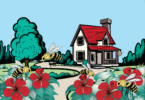Athens, Ga. – With the costs of health care soaring and no solution in sight, we need to look hard at lower-cost alternatives, like trees. Yes, trees. Whole trees. Green, growing trees.
Trees are strong medicine, says Kim Coder, a forestry professor with the University of Georgia’s Warnell School of Forest Resources. They provide a psychological value not many people realize.
“There have been some studies dealing with hospital patients,” Coder said. “Some of the patients had views of trees outside their windows, and others didn’t. Some had photos of trees by their beds. Those who had that natural environment to look at needed less pain medication and recovered faster. They got out of the hospital quicker.”
In urban settings where steel and glass and plastic and concrete are the rule, other studies have measured the heart rates of people with and without trees.
“It’s amazing, the physiological response people have to trees,” Coder said. “With trees around them, people’s heart rates dropped. They felt comfortable and calm.”
Coder said many retail businesses take advantage of this psychological value of trees.
“Where there are trees, people feel more comfortable and safer, and they’re more inclined to linger,” he said. “That translates into more money for the businesses.”
That almost medicinal value of trees isn’t easy to measure.
“We can come up with a dollar value for a tree for insurance, tax and real estate purposes,” Coder said. “But it may be worth a lot more than that. “Psychological benefits aren’t easily quantifiable, but they still have tremendous value for people who live with trees.”
How do trees make people feel better?
A tangible, measurable part of trees’ effect on people is their sound. It’s “white noise,” or soft sounds that hide other, more stressful, noises.
“A car ripping past or a jackhammer is noise,” Coder said. “Hearing the wind rustling the leaves covers up some of that bad noise.”
The green of the leaves seems to calm us, too. In urban settings with hard lines and glaring sun, the shade and green and soft form of trees is soothing, Coder said.
But part of trees’ value, Coder believes, is less tangible. It’s deeply ingrained in humans from our distant past.
“When people see trees around them they just feel that’s where they ought to be,” he said. “When I go home and walk through my yard, for instance, I lose all of the aggressiveness and tension of the drive home.”
You can measure the noise a tree filters out, the cooling effect of its shade, its real estate value ‒ even the volume of pollutants it removes and the oxygen it adds to the air, he said.
“But when you lose a tree, you lose more than that,” he said. “Trees have psychological, sentimental, historic and social value ‒ those things get tied up with what it is to be human.”
Coder wishes more people understood trees’ value.
“From the 1890s to the 1920s,” he said, “people in Georgia planted a heck of a lot of trees. Look around: many of those big, old, beautiful, soothing trees around us are there because somebody had the foresight to get them started.”
People now need to follow their ancestors’ example, he said, and plant more trees.
“Georgia has a tradition of tree-planting that we need to follow, for the sake of our children,” Coder said. “We need to invest in the future. And planting one Arbor Day tree a year isn’t enough. Somebody needs to be planting a lot of trees.







